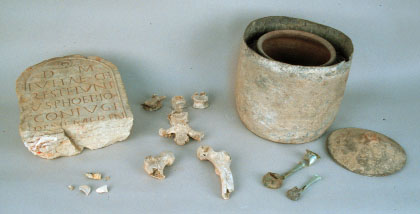



The Romans maintained a very systematic approach when tending to the dead. First, relatives would close the deceased's eyes while calling out the name of their dearly departed. The body was then washed and a coin was placed in the mouth. The coin was payment to Charon, who ferried the dead across the rivers of the underworld.
Social status was an important factor in the Roman funeral. The dead were put on display: the length of this ancient "wake" depended upon the departed person's position in society. Upper-class individuals, such as the nobility, were often put on display for as long as a week, offering many opportunities for many mourners to pay their final respects. Lower class members of society, on the other hand, were often cremated after only one day.
After the display, a funerary procession followed. Roman funerals were typically held at night to prevent large public gatherings and discourage crowds and excessive mourning which, in the case of major political figures, could lead to serious unrest. Hired musicians led the parade, followed by mourners and relatives who often carried portrait sculptures or wax masks of other deceased family members. The procession would end outside of town (it was forbidden to bury anyone within the city limits) and a pyre, or cremation fire, was built. As the fire burned, a eulogy was given in honor of the deceased. After the pyre was extinguished, a family member (usually the deceased's mother or wife) would gather the ashes and place them in an urn.
Many Romans belonged to funeral societies, called collegia, to ensure proper burial. They would pay monthly dues, which would be employed to cover the cost of funerals for members. Collegia members (provided they were in good standing) were guaranteed a spot in a columbarium. Columbaria were large underground vaults where peoples' cremated remains were placed within small wall niches, which were often marked by memorial plaques and portrait sculptures. Because the Romans believed that a proper burial was essential for passage to the afterlife, there was much concern on this score. Columbaria were an inexpensive way to guarantee this transition, and collegia allowed all classes of society to reach the underworld. Some emperors even provided funeral allowances to those so very poor they could not even afford to belong to a collegia.
**Please note: this "assemblage" was created solely for educational purposes. While the cremation urn KM 2903 and its contents may reflect an actual burial (it was purchased in the 1920's in Puteoli, Italy), the other objects in this "assemblage" (inscription, columbarium, and melted glass) do not come from the same archaeological context. A full explanation of this class project is found on the introductory page for this website.